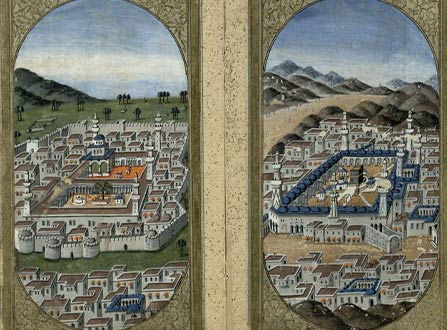Hajj
The hajj pilgrimage is one of the central rituals of Islam. Beginning on the eighth day of the Islamic month of Dhū al-Ḥijja, the pilgrimage draws millions of visitors annually to the holy cities of Mecca and Medina. Every able-bodied Muslim who has the financial means is obligated to perform the hajj at least once in his or her lifetime. Among those who undertook the pilgrimage over the centuries were Muslim scholars, many of whom would remain in Mecca and Medina for months or years; in this way, the two sacred cities became sites of dynamic scholarly exchange.
The hajj rituals, which take place over the course of five or six days, follow a prescribed order. Having entered a state of ritual purity (ihram) pilgrims first circumambulate (ṭawāf) the Kaaba, the central, black-draped square edifice set inside the Grand Mosque, seven times, then pray in the mosque and drink water from the Zamzam well located there. Following ṭawāf, pilgrims run or walk (sa‘i) back and forth seven times between the adjoining hills of Ṣafā and Marwa. Originally outside, the circuit between the hills is now enclosed within the mosque complex. Other central hajj rituals include wuqūf (“standing,” i.e., before God), on the plain of Arafat, some 20 kilometers east of Mecca, a contemplative practice of listening to sermons, prayer, and atonement, and throwing pebbles at three pillars representing the devil on the nearby plain of Mina. Following this ritual stoning, animals are sacrificed—today, pilgrims often purchase a voucher for the sacrifice to be performed in their name—and the meat is donated to the poor. On that same day, Muslims the world over also sacrifice animals as part of the Eid al-Adha holiday.
The Prophet Muhammad was born in Mecca in 570 CE, and following in the footsteps of the prophet remains a central aspect of the hajj. But the Muslim tradition also associates many of the rituals with the story of Abraham. The sa‘i between Ṣafā and Marwa, for instance, appears in the story of the handmaiden Hagar’s desperate search for water for her son Ishmael. The Kaaba itself, another story states, was built by Abraham with Ishmael’s help. First mentioned in the Quran, these and other stories are expanded in numerous works belonging to the “stories of the prophets” (qiṣaṣ al-anbiyāʾ) genre of Muslim commentary literature.




